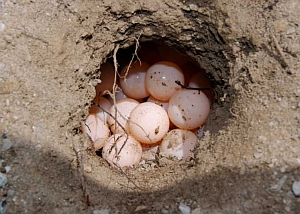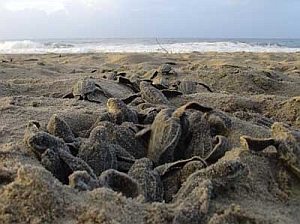Philadelphia - For eastern Pacific populations of leatherback turtles, the 21st century could be the last. New research suggests that climate change could exacerbate existing threats and nearly wipe out the population.
Deaths of turtle eggs and hatchlings in nests buried at hotter, drier beaches are the leading projected cause of the potential climate-related decline, according to a new study in the journal Nature Climate Change by a research team from Drexel University, Princeton University, other institutions and government agencies.
Leatherbacks, the largest sea turtle species, are among the most critically endangered due to a combination of historical and ongoing threats including egg poaching at nesting beaches and juvenile and adult turtles being caught in fishing operations.
The new research on climate dynamics suggests that climate change could impede this population's ability to recover. If actual climate patterns follow projections in the study, the eastern Pacific population of leatherback turtles will decline by 75% by the year 2100.
 |
Leatherback turtle births naturally ebb and flow from year to year in response to climate variations, with more hatchlings, and rare pulses of male hatchlings, entering the eastern Pacific in cooler, rainier years.
Female turtles are more likely to return to nesting beaches in Costa Rica to lay eggs in years when they have more jellyfish to eat, and jellyfish in the eastern Pacific are likely more abundant during cooler seasons.
Turtle eggs and hatchlings are also more likely to survive in these cooler, rainier seasons associated with the La Niņa climate phase. In addition, temperature inside the nest affects turtles' sex ratio, with most male hatchlings emerging during cooler, rainier seasons to join the predominantly-female leatherback turtle population.
Projections indicate that warmer, drier years will become increasingly frequent in Central America throughout this century. High egg and hatchling mortality associated with warmer, drier beach conditions was the most significant cause of the projected climate-related population decline. The nesting population of leatherbacks could decline by 7% per decade, or 75% overall by the year 2100.
"In 1990, there were 1,500 turtles nesting on the Costa Rican beach of Playa Grande," said Dr. James Spotila, the Betz Chair Professor of Environmental Science in the College of Arts and Sciences at Drexel. "Now, there are 30 to 40 nesting females per season."
 |
Poaching of turtle eggs was a major cause of the initial decline, and was once such a widespread problem that virtually no turtle hatchlings would survive at Playa Grande. Environmentalists worked with the local authorities in Costa Rica to protect the leatherbacks' nesting beaches so that turtle nests can hatch in safety.
Bycatch of juvenile and adult turtles in fishing operations in the eastern Pacific remains a threat.
For the population to recover successfully the challenge is to produce as many good hatchlings as possible. This requires human intervention, to manipulate the beach and increase the hatchling's chance at survival.
Research teams are already investigating methods such as watering and shading turtle nests that could mitigate the impact of hot, dry beach conditions on hatching success. We just can't afford to lose wildlife like these valuable resources of an evolutionary past and an ecological future.


